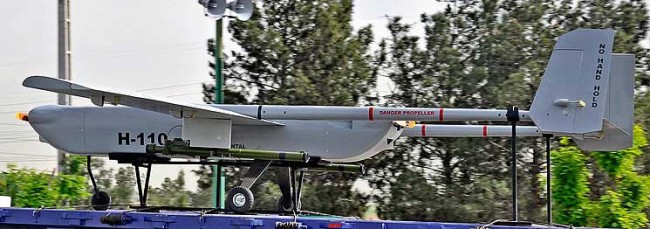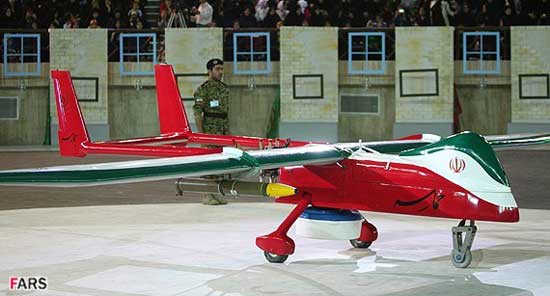The Hamaseh drone unveiled last week is one of Iran’s new generation of drones, based on designs that follow proven western UAVs. Hamaseh clearly resembles the Israeli Heron. Photo: FARS
Last week Iran unveiled its latest drone dubbed “Hamaseh”. This unmanned aerial vehicle follows a classic twin-boom tail design, pioneered by IAI’s Scout and Tadiran Mastiff in the 1980s. On the My 9, 2013 unveiling ceremony the drone was shown carrying two 107mm rockets and what seems to be an electronic payload – probably a radar. The Iranians say it can ‘avoid detection by the enemy thanks to its stealth features’, but based on visual impression of the aircraft shown in flight, the overall shape and non-stealth features such as the non retractable landing gear, wing strakes (beefing up the hard-points) would negate signature reduction to a level considered ‘stealthy’ by western standards. According to the Iranians, Hamaseh is designed for reconnaissance and combat missions.
Regardless of the maturity of the current Hamaseh, the design represents a new level of maturity for Iran’s drone program, which currently includes about 40 different types of drones. Of these, about 30 are in different phases of production.
In recent months the Iranians have released a number of drones.
Another drone unveiled in 2012 was Shahed 129 followed another Israeli design – the Hermes 450. In April 2013 Tehran unveiled four new drone programs – Azem-2, Mohajer B, Hazem 3 and Sarir H110, dubbed as a ‘long-endurance drone’. Sharir 110 was first shown on a march in Tehran, on April 10, 2013. As other recently unveiled Iranian designs, this drone follows the design of the Israeli Hunter (Developed by IAI), which has seen operational use with the US Army in Iraq and Afghanistan over the past decade. Sharir 110 is also configured with a twin-boom tail, and is powered by two propellers used in tractor-pusher configuration. This drone was also displayed carrying external weapons on wing pylons (it was displayed with two SA-7 class air/air missiles). Iran also claims this drone is stealthy, but its design does not indicate any such attributes.
long endurance missions. It was displayed on the April 2012 Army Day military parade in Tehran. The drone follows the lines of the Israeli Hunter UAV.

H-110 Sarir is a twin-engine UAV designed for long endurance missions. It was displayed on the April 2012 Army Day military parade in Tehran. The drone follows the lines of the Israeli Hunter UAV.
Tehran is developing the operational techniques, tactics and procedures (TTP) for these unmanned systems in parallel to the continuous development of systems. Unmanned systems are integrated in all exercises, on both sides. Iran regularly trains its forces and air defenses in counter-surveillance measures, and specific counter-UAV techniques. These have culminated in the ‘abduction’ of an RQ-170 Sentinel, the top-secret CIA drone operated from Afghanistan in 2011. The Sentinel was said to be on surveillance missions over east-central Iran when Tehran’s electronic warfare units claimed to have managed to deceive its navigation and command links, landing the drone undamaged in Iran. It is assumed that by reverse engineering some of the RQ-170 design features the Iranians could implement signature reduction capabilities, particularly in electromagnetic shielding, use of materials and the topology of elements, achieving a level of low observability in their newer drones. Nevertheless, the adaptation of overall stealth design, that requires complex manufacturing techniques, exotic materials and use of advanced aerodynamic control are probably beyond the scope of Iran’s current achievements, hence the lack of visible ‘stealth shaped’ drones.
Since 2006 Iran also launched several surveillance missions over Israel, through its Hezbollah Lebanese proxy organization. In 2006 and 2011 Hezbollah used Ababil drones on strike missions directed at Israel. In all occasions the drones were intercepted by Israel Air Force jet fighters.
Aware of the Ababil’s limited stealth capability, Iran is trying to reduce the detectability and signatures of its newer drones. On the more recent missions Iranian drones achieved more impressive results; on one occasion, in October 2012 the new Shahed 129 managed to fly from Lebanon and conduct a reconnaissance mission over Southern Israel, for about 30 minutes before being intercepted. Iranian sources said it was not the first time they flew such missions over Israel, but did not present any proof for these claims. The Israelis have learned their lessons, on another mission launched in April 2013 an Iranian drone was intercepted long before approaching the Israeli coastline.

No comments:
Post a Comment